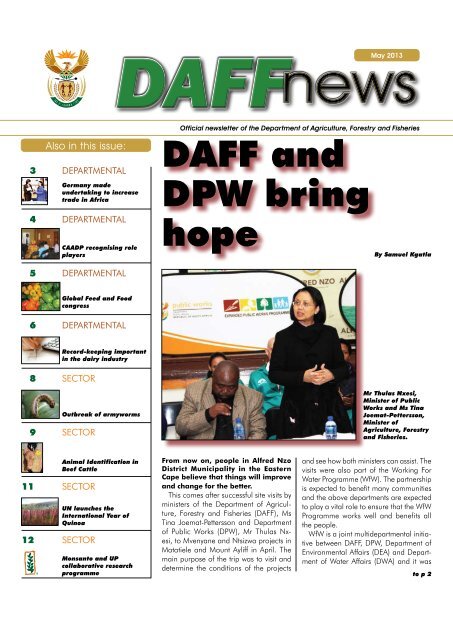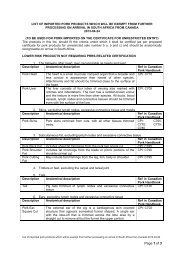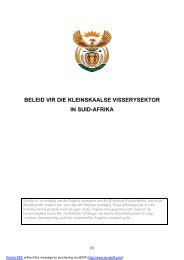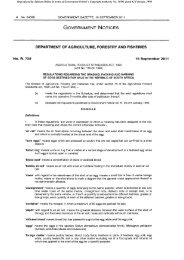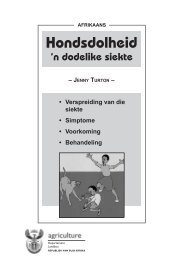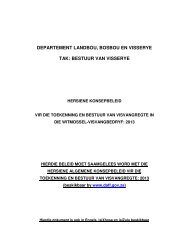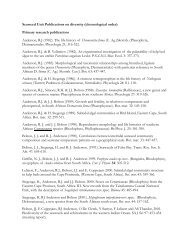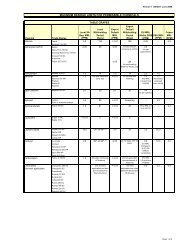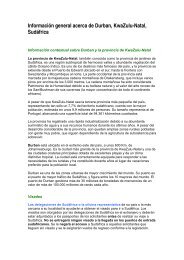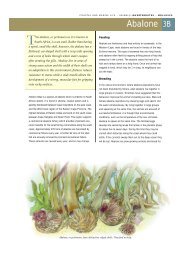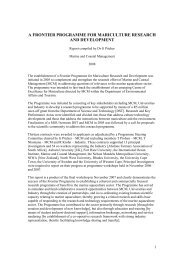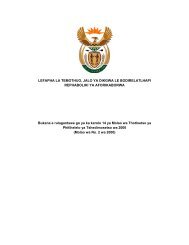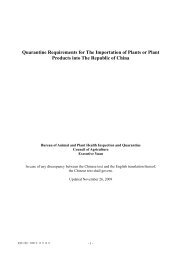DAFF - Department of Agriculture, Forestry and Fisheries
DAFF - Department of Agriculture, Forestry and Fisheries
DAFF - Department of Agriculture, Forestry and Fisheries
You also want an ePaper? Increase the reach of your titles
YUMPU automatically turns print PDFs into web optimized ePapers that Google loves.
<strong>DAFF</strong><br />
May 2013<br />
Official newsletter <strong>of</strong> the <strong>Department</strong> <strong>of</strong> <strong>Agriculture</strong>, <strong>Forestry</strong> <strong>and</strong> <strong>Fisheries</strong><br />
3<br />
4<br />
Also in this issue:<br />
DEPARTMENTAL<br />
Germany made<br />
undertaking to increase<br />
trade in Africa<br />
DEPARTMENTAL<br />
<strong>DAFF</strong> <strong>and</strong><br />
DPW bring<br />
hope<br />
CAADP recognising role<br />
players<br />
By Samuel Kgatla<br />
5<br />
DEPARTMENTAL<br />
Global Feed <strong>and</strong> Food<br />
congress<br />
6<br />
DEPARTMENTAL<br />
Record-keeping important<br />
in the dairy industry<br />
8<br />
SECTOR<br />
9<br />
Outbreak <strong>of</strong> armyworms<br />
SECTOR<br />
Mr Thulas Nxesi,<br />
Minister <strong>of</strong> Public<br />
Works <strong>and</strong> Ms Tina<br />
Joemat-Pettersson,<br />
Minister <strong>of</strong><br />
<strong>Agriculture</strong>, <strong>Forestry</strong><br />
<strong>and</strong> <strong>Fisheries</strong>.<br />
11<br />
12<br />
Animal Identification in<br />
Beef Cattle<br />
SECTOR<br />
UN launches the<br />
International Year <strong>of</strong><br />
Quinoa<br />
SECTOR<br />
Monsanto <strong>and</strong> UP<br />
collaborative research<br />
programme<br />
From now on, people in Alfred Nzo<br />
District Municipality in the Eastern<br />
Cape believe that things will improve<br />
<strong>and</strong> change for the better.<br />
This comes after successful site visits by<br />
ministers <strong>of</strong> the <strong>Department</strong> <strong>of</strong> <strong>Agriculture</strong>,<br />
<strong>Forestry</strong> <strong>and</strong> <strong>Fisheries</strong> (<strong>DAFF</strong>), Ms<br />
Tina Joemat-Pettersson <strong>and</strong> <strong>Department</strong><br />
<strong>of</strong> Public Works (DPW), Mr Thulas Nxesi,<br />
to Mvenyane <strong>and</strong> Ntsizwa projects in<br />
Matatiele <strong>and</strong> Mount Ayliff in April. The<br />
main purpose <strong>of</strong> the trip was to visit <strong>and</strong><br />
determine the conditions <strong>of</strong> the projects<br />
<strong>and</strong> see how both ministers can assist. The<br />
visits were also part <strong>of</strong> the Working For<br />
Water Programme (WfW). The partnership<br />
is expected to benefit many communities<br />
<strong>and</strong> the above departments are expected<br />
to play a vital role to ensure that the WfW<br />
Programme works well <strong>and</strong> benefits all<br />
the people.<br />
WfW is a joint multidepartmental initiative<br />
between <strong>DAFF</strong>, DPW, <strong>Department</strong> <strong>of</strong><br />
Environmental Affairs (DEA) <strong>and</strong> <strong>Department</strong><br />
<strong>of</strong> Water Affairs (DWA) <strong>and</strong> it was<br />
to p 2
<strong>Department</strong>al<br />
CEO Forum meeting<br />
By Musa Khumalo<br />
The <strong>Department</strong> <strong>of</strong> <strong>Agriculture</strong>, <strong>Forestry</strong><br />
<strong>and</strong> <strong>Fisheries</strong>, in association<br />
with the CEOs <strong>of</strong> the different private<br />
sectors, held a meeting sponsored by<br />
the Industrial Development Cooperation<br />
(IDC) on issues that challenge both<br />
government <strong>and</strong> the private sector at<br />
the Saint Georges Hotel <strong>and</strong> Conference<br />
Centre on 24 April 2012.<br />
The CEO Forum meeting is held twice<br />
every year <strong>and</strong> involves the partnership<br />
between government <strong>and</strong> the private<br />
sectors in agriculture, forestry <strong>and</strong> fisheries.<br />
The chairpersonship rotates between<br />
the industry <strong>and</strong> the department’s senior<br />
head, Acting Director-General Mr Sipho<br />
Ntombela.<br />
Decisions were taken during the meeting<br />
regarding the L<strong>and</strong> Audit <strong>and</strong> the uncertainty<br />
that surrounds l<strong>and</strong> policies. It was<br />
agreed that the Director-General or the<br />
Chief L<strong>and</strong> Surveyor <strong>of</strong> Rural Development<br />
<strong>and</strong> L<strong>and</strong> Reform would be present in the<br />
next meeting to present a comprehensive<br />
picture <strong>of</strong> their policy initiatives around<br />
l<strong>and</strong> reform.<br />
With regard to the Strategic Infrastructure<br />
Project 11 (SIP 11) which addresses<br />
agro-logistics <strong>and</strong> rural infrastructure<br />
constraints in the country, the National<br />
Agricultural Marketing Council (NAMC)<br />
has been commissioned by the department<br />
to monitor <strong>and</strong> evaluate SIP 11,<br />
which is a partnership between the private<br />
<strong>and</strong> public sectors. Mr Sipho Ntombela<br />
suggested that the private sector, though<br />
it has self-funded projects, should report<br />
to the department on the progress. In this<br />
way, the department could assist them with<br />
skills development <strong>and</strong> funding, among<br />
other things, so that the department can<br />
keep a record <strong>of</strong> job creation within the<br />
sector.<br />
The small, medium <strong>and</strong> micro enterprises<br />
(SMMEs) from the West Coast rock<br />
lobster sector, represented by Ms Mymoena<br />
Poggenpoel, commented on the joys<br />
<strong>of</strong> working with the department <strong>and</strong> they<br />
were pleased with the way <strong>of</strong> addressing<br />
the issues <strong>of</strong> small-scale fisheries.<br />
There is an implementing body which<br />
meets every six weeks <strong>and</strong> serves as the<br />
arm <strong>of</strong> the forum. The steering committee<br />
oversees <strong>and</strong> reports to the plenary on<br />
implementations that were discussed <strong>and</strong><br />
implemented.<br />
The next forum meeting will be held in<br />
October 2013.<br />
<strong>DAFF</strong> <strong>and</strong> DPW bring hope<br />
from p 1<br />
established many years ago. The WfW<br />
is a public funded national programme<br />
<strong>of</strong> DEA that aims at clearing, controlling<br />
<strong>and</strong> eradicating alien invasive plants.<br />
The WfW provides a vehicle for using the<br />
employment opportunities that arise from<br />
dealing with the environmental threat <strong>of</strong><br />
invading alien plants. In the longer term,<br />
however, some cost-effective means must<br />
be found to prevent reinvasion <strong>of</strong> cleared<br />
areas. The programme also contributes to<br />
job creation for local communities, which<br />
includes processing the plant material which<br />
has been harvested.<br />
Minister Joemat-Pettersson said that they<br />
need to commit themselves to the projects<br />
<strong>and</strong> see how they can improve the situation.<br />
“We must combine all our resources to<br />
make sure that our people are assisted. The<br />
government cannot do it alone, but we also<br />
need assistance from private companies. We<br />
must have a high-level management team<br />
to be involved in these projects. I am glad<br />
we are involved in this WfW programme.<br />
Together with DPW, we must provide fencing,<br />
seed, fertilisers <strong>and</strong> others. We are also<br />
planning to resuscitate the irrigation scheme<br />
around the uMzimvubu Dam. We must deal<br />
with the WfW programme first <strong>and</strong> then<br />
other projects can come in,” she said.<br />
The Minister also advised people to<br />
consider the issue <strong>of</strong> one family one food<br />
garden <strong>and</strong> one school one garden to<br />
eradicate hunger.<br />
Minister Nxesi outlined that they will<br />
only be prosperous if they can continue to<br />
work together <strong>and</strong> reiterated that their visits<br />
should yield positive results. He continued<br />
that they want the WfW programme to work<br />
effectively. “People must be trained in this<br />
project so that they start working on their<br />
own. There is sufficient water from rivers<br />
flowing to the sea <strong>and</strong> this can be stopped<br />
by building a dam. We must also remove<br />
the middlemen who are impeding service<br />
delivery. We will continue to collaborate<br />
with <strong>DAFF</strong> to fast-track service delivery,”<br />
concluded Nxesi.<br />
<strong>DAFF</strong>news is the newsletter <strong>of</strong> the <strong>Department</strong> <strong>of</strong> <strong>Agriculture</strong>, <strong>Forestry</strong><br />
<strong>and</strong> <strong>Fisheries</strong>. Private Bag X250, PRETORIA 0001.<br />
It is published by the Directorate Communication Services, Private Bag<br />
X144, PRETORIA 0001.<br />
Opinions expressed in <strong>DAFF</strong>news are not necessarily those <strong>of</strong> the<br />
editorial team. No part <strong>of</strong> this newsletter may be reproduced or<br />
transmitted in any form or by any means, including photocopying,<br />
recording or any information storage or retrieval system without prior<br />
permission from the editor.<br />
<strong>DAFF</strong>news is printed on triple green paper.<br />
Editor Piwe Mbiko (012) 319 6936 piwem@daff.gov.za<br />
Reporters Thuli Dube (012) 319 7929 nokuthulad@daff.gov.za<br />
Samuel Kgatla (012) 319 7181 samuelk@daff.gov.za<br />
Innocent Mhlanga (012) 319 7827 innocentm@daff.gov.za<br />
Rony Moremi (012) 319 6622 rincertm@daff.gov.za<br />
Mercia Smith (012) 319 6666 mercias@daff.gov.za<br />
Interns Elias Sekgwele (012) 319 7819 eliass@daff.gov.za<br />
Zwiswa Mulaudzi (012) 319 6958 zwiswam@daff.gov.za<br />
Subeditors Lerato M<strong>of</strong>okeng (012) 319 7927 leratom<strong>of</strong>@daff.gov.za<br />
Willie de Jager (012) 319 6636 williedj@daff.gov.za<br />
Distribution Pam Sutherl<strong>and</strong> (012) 319 7104 pamsu@daff.gov.za<br />
Website: www.daff.gov.za<br />
2<br />
May 2013 <strong>DAFF</strong>news No. 5
<strong>Department</strong>al<br />
Germany made<br />
undertaking to increase<br />
trade in Africa<br />
The South African Minister <strong>of</strong> <strong>Agriculture</strong>,<br />
<strong>Forestry</strong> <strong>and</strong> <strong>Fisheries</strong>, Ms Tina<br />
Joemat-Pettersson, held a bilateral<br />
meeting with the German Minister <strong>of</strong><br />
Food, <strong>Agriculture</strong> <strong>and</strong> Consumer Protection,<br />
Ms Ilse Aigner, recently.<br />
The two ministers had discussions on<br />
issues relating to current agricultural <strong>and</strong><br />
trade policies, world food security <strong>and</strong><br />
cooperation in vocational training.<br />
Last week, Germany made an undertaking<br />
to increase trade in Africa, <strong>and</strong> South<br />
Africa in particular. South Africa exports<br />
close to R3 billion <strong>of</strong> fresh citrus fruit annually<br />
to the European Union. Germany is<br />
one <strong>of</strong> the major markets for South African<br />
citrus in the <strong>of</strong>f-season <strong>of</strong> EU producers<br />
which includes mainly Spain, Italy <strong>and</strong><br />
Greece. Approximately 40% <strong>of</strong> SA citrus<br />
exports go to the EU.<br />
The meeting culminated in the signing <strong>of</strong><br />
a statement <strong>of</strong> intent regarding cooperation<br />
in the field <strong>of</strong> initial <strong>and</strong> continuing<br />
vocational training for favourable economic<br />
development <strong>of</strong> an agricultural<br />
holding <strong>and</strong> for providing the population<br />
with safe food.<br />
Minister Joemat-Pettersson highlighted<br />
some <strong>of</strong> these issues, among others, South<br />
African citrus exports to the EU. South<br />
Africa mainly exports wines, paper <strong>and</strong><br />
processed fruit <strong>and</strong> vegetables, including<br />
fresh grapes <strong>and</strong> other products to<br />
Germany.<br />
As part <strong>of</strong> the trade partnership between<br />
the two countries, South Africa is looking<br />
at an agreement for the protection <strong>of</strong><br />
Geographical Indications (GIs) with regard<br />
to agricultural products such as cheese,<br />
meat products, olive oil, etc. The EU has<br />
a well-developed GI protection system.<br />
South Africa has just started with products<br />
like rooibos <strong>and</strong> honeybush tea.<br />
To date Germany has signed the following<br />
agreements with South Africa:<br />
• Declaration <strong>of</strong> Intent to Cooperation<br />
in the fields <strong>of</strong> Assistance to Cooperative,<br />
Legislation on Cooperation <strong>and</strong><br />
Assistance to Directorate Business<br />
Ms Ilse Aigner, German Minister <strong>of</strong> Food, <strong>Agriculture</strong> <strong>and</strong> Consumer Protection, with<br />
Ms Tina Joemat-Pettersson, Minister <strong>of</strong> <strong>Agriculture</strong>, <strong>Forestry</strong> <strong>and</strong> <strong>Fisheries</strong>, after<br />
signing the statement <strong>of</strong> intent regarding cooperation in the field <strong>of</strong> initial <strong>and</strong><br />
continuing vocational training.<br />
<strong>and</strong> Industrial Development signed<br />
10 October 1999.<br />
• Agreement with SA regarding the<br />
Development <strong>of</strong> Advisory Services<br />
in the Northern Province signed 10<br />
December 1999.<br />
• A Cooperation Agreement was signed<br />
between the Federal Republic <strong>of</strong><br />
Germany <strong>and</strong> the Republic <strong>of</strong> South<br />
Africa on Cooperation in the Field <strong>of</strong><br />
Veterinary Affairs on 26 September<br />
2008.<br />
• A Declaration <strong>of</strong> Intent on Cooperation<br />
in the Field <strong>of</strong> Initial <strong>and</strong> Continu-<br />
ing Vocational Training was signed 26<br />
September 2008.<br />
Says Minister Joemat-Pettersson: “South<br />
Africa’s partnership with Germany has<br />
historical roots. Moreover, our partnership<br />
since the advent <strong>of</strong> democracy has<br />
gone from strength to strength. Today’s<br />
bilateral will enhance the skills <strong>of</strong> our <strong>of</strong>ficials.<br />
This has major benefits not only for<br />
the department but for the general South<br />
African public. We welcome this move<br />
<strong>and</strong> look forward to even more investment<br />
opportunities.”<br />
No. 5 <strong>DAFF</strong>news May 2013<br />
3
<strong>Department</strong>al<br />
CAADP recognising role<br />
players<br />
By Rony Moremi<br />
In recognition <strong>of</strong> the central role<br />
played by agriculture in alleviating<br />
poverty <strong>and</strong> hunger <strong>and</strong> its contribution<br />
towards realising the Millennium<br />
Development Goals, the African Heads<br />
<strong>of</strong> State endorsed the Comprehensive<br />
African Agricultural Development Programme<br />
(CAADP) in July 2003.<br />
The main focus <strong>of</strong> CAADP is to encourage<br />
increased public investment in agriculture<br />
(by 10%) to reach a target goal <strong>of</strong><br />
6% in the sector.<br />
Since the endorsement, the <strong>Department</strong><br />
<strong>of</strong> <strong>Agriculture</strong>, <strong>Forestry</strong> <strong>and</strong> <strong>Fisheries</strong><br />
(<strong>DAFF</strong>) together with the New Partnership<br />
for Africa’s Development (NEPAD) National<br />
Planning <strong>and</strong> Coordinating Agency<br />
(NPCA) <strong>and</strong> the Food <strong>and</strong> <strong>Agriculture</strong><br />
Organization (FAO) hosted a Stakeholder<br />
Sensitisation Seminar in October 2012 to<br />
evaluate existing South African policies<br />
<strong>and</strong> identify avenues to effectively implement<br />
CAADP in South Africa.<br />
A need to establish a national CAADP<br />
country team emanated as a resolution<br />
from the Stakeholder Sensitisation<br />
Seminar. The country team is formed<br />
by <strong>DAFF</strong>, <strong>Department</strong> <strong>of</strong> Rural Development<br />
<strong>and</strong> L<strong>and</strong> Reform (DRLD), National<br />
Treasury, the Presidency (Monitoring <strong>and</strong><br />
Evaluation), Agricultural Business Chamber<br />
(Agbiz),Transvaal Agricultural Union<br />
<strong>of</strong> South Africa (TAU SA), Agri SA, Food<br />
<strong>and</strong> Allied Workers’ Union (FAWU), NAFU<br />
(National African Farmers’ Union) <strong>and</strong><br />
AFASA (African Farmers’ Association <strong>of</strong><br />
South Africa).<br />
As a continuation <strong>of</strong> stakeholder engagement,<br />
<strong>DAFF</strong> together with the NPCA<br />
<strong>and</strong> FAO, hosted another workshop in<br />
February 2013. The aim <strong>of</strong> the workshop<br />
was to provide a platform for dialogue<br />
<strong>and</strong> come up with priorities <strong>and</strong> a commitment<br />
to develop a shared roadmap for<br />
the implementation <strong>of</strong> CAADP.<br />
During his opening remarks Mr Andile<br />
Hawes, DDG for Policy Planning <strong>and</strong><br />
Monitoring <strong>and</strong> Evaluation, said it is very<br />
important for programmes to make a<br />
meaningful contribution to communities<br />
through social mobilisation. He emphasised<br />
that programmes should have a<br />
positive impact on the economic growth<br />
<strong>of</strong> the country.<br />
In agreement with Mr Hawes, the FAO<br />
Representative in South Africa, Dr Tobias<br />
Takavarasha, said the days <strong>of</strong> planning for<br />
the mere sake <strong>of</strong> planning are over. He<br />
Winston Makabanyane interacting with stakeholders during one the four<br />
consultative group sessions.<br />
said 40 countries have already launched<br />
CAADP <strong>and</strong> 30 compacts have been<br />
signed; he further explained that signing<br />
the compact is like making marriage vows.<br />
A compact is a strategic benchmark in the<br />
country roundtable process. It is signed by<br />
key stakeholders <strong>and</strong> players in the country<br />
to demonstrate commitment to a shared vision<br />
<strong>and</strong> emerging strategies to collectively<br />
address the country’s agricultural development<br />
agenda. This endorsement puts a seal<br />
on the commitment <strong>of</strong> all parties to support<br />
<strong>and</strong> work towards increasing investment in<br />
the <strong>Agriculture</strong> sector. He also informed the<br />
delegates that ten countries which signed<br />
the compact have reached <strong>and</strong> surpassed<br />
the 10% budget target <strong>and</strong> reached a<br />
growth rate <strong>of</strong> 4,5% per annum in 2003 to<br />
2009. The FAO has committed US$96,661<br />
to the RSA for the review <strong>and</strong> alignment <strong>of</strong><br />
Agricultural Policies with the CAADP pillars.<br />
The four CAADP pillars are: Sustainable<br />
l<strong>and</strong> <strong>and</strong> water management (including<br />
reliable water control systems); improving<br />
rural infrastructure <strong>and</strong> trade related<br />
capacities for market access; increasing<br />
food supply, reducing hunger <strong>and</strong> improving<br />
responses to food emergencies; <strong>and</strong><br />
improving agriculture research, technology<br />
dissemination <strong>and</strong> adoption.<br />
One <strong>of</strong> the most important factors <strong>of</strong><br />
CAADP implementation is operationalisation<br />
at provincial level by the provincial<br />
departments <strong>of</strong> agriculture. Provincial<br />
consultations are under way <strong>and</strong> so far<br />
the North West provincial consultation<br />
has been held in August 2012. These provincial<br />
consultations will culminate in the<br />
national <strong>and</strong> provincial specific priorities<br />
<strong>and</strong> strategies, which will assist in designing<br />
investment plans <strong>and</strong> they will be aligned<br />
to the national government priorities. It is<br />
anticipated that the South African compact<br />
will be signed this year by the Minister <strong>of</strong><br />
<strong>DAFF</strong>, Minister <strong>of</strong> Finance, the Presidents<br />
<strong>of</strong> the agricultural unions as well as the<br />
President <strong>of</strong> the Congress <strong>of</strong> South African<br />
Trade Unions (Cosatu) <strong>and</strong> representatives<br />
<strong>of</strong> the private sector.<br />
4<br />
May 2013 <strong>DAFF</strong>news No. 5
<strong>Department</strong>al<br />
Global<br />
Feed <strong>and</strong> Food<br />
Congress<br />
Sun City International was abuzz with<br />
global feed <strong>and</strong> food value experts for<br />
a good cause. The 650 global leaders<br />
from various parts <strong>of</strong> the world<br />
converged for the 4 th Global Feed <strong>and</strong><br />
Food Congress (GFFC) in North West,<br />
South Africa from 10 to 12 April 2013.<br />
This was the first time it was held on<br />
African soil after it had been hosted in<br />
Brazil in 2005 <strong>and</strong> 2007, as well as in<br />
Mexico in 2010.<br />
The theme for the 4 th GFFC, which is<br />
“Safe Feed <strong>and</strong> Food for All” links to the<br />
global challenge to feed 9 billion people<br />
by 2050 <strong>and</strong> to do so sustainably. The<br />
theme further reflects the aspirations <strong>of</strong> the<br />
entire feed <strong>and</strong> food value chain. The main<br />
aim <strong>of</strong> the event organised by the Animal<br />
Feed Manufacturers’ Association (AFMA),<br />
International Feed Industry Federation<br />
(IFIF) <strong>and</strong> Food <strong>and</strong> <strong>Agriculture</strong> Organization<br />
<strong>of</strong> the United Nations (FAO) has<br />
always been to provide a global platform<br />
for the industry, experts <strong>and</strong> governments<br />
to come together to discuss critical issues<br />
<strong>of</strong> food <strong>and</strong> feed safety, technology <strong>and</strong><br />
sustainability.<br />
Pr<strong>of</strong>essor Hlengiwe Mkhize, Deputy<br />
Minister <strong>of</strong> Economic Development, represented<br />
the South African government<br />
<strong>and</strong> said that South Africa is proud to be<br />
hosting the 4 th GFFC.<br />
“In South Africa, when we talk about<br />
food security we also include the issue <strong>of</strong><br />
l<strong>and</strong> reform. Even our President, Jacob<br />
Zuma, alluded to that during his State <strong>of</strong><br />
the Nation Address this year. <strong>Agriculture</strong><br />
remains one <strong>of</strong> the most important drivers<br />
<strong>of</strong> our economy. Our small-scale farmers<br />
must be assisted so that our l<strong>and</strong> can be<br />
more productive. This congress affords<br />
us the opportunity to review the key legislative,<br />
trade <strong>and</strong> practical aspects <strong>of</strong> a<br />
sector that plays a key role in food safety<br />
<strong>and</strong> security,” she said.<br />
She further urged delegates to learn<br />
from one another <strong>and</strong> to recognise the<br />
importance <strong>of</strong> transfer <strong>of</strong> technology <strong>and</strong><br />
partnerships, which are the key to increasing<br />
global feed <strong>and</strong> food production <strong>and</strong><br />
food security worldwide.<br />
Mario Sergio Cutait, Chairperson <strong>of</strong><br />
IFIF thanked the people <strong>of</strong> Africa, especially<br />
South Africans, for their hospitality.<br />
He also added that that the congress was<br />
first class in terms <strong>of</strong> organisation.<br />
“I think the feed <strong>and</strong> food industry does<br />
not know how strong <strong>and</strong> powerful we<br />
are. We must be proud <strong>of</strong> what we did<br />
in South Africa. I close the congress with<br />
more energy than that which I had when<br />
I was opening it. The congress was the<br />
best <strong>and</strong> we had many good speakers.<br />
I want to thank you all <strong>and</strong> I hope to<br />
see you soon at our next meeting,” he<br />
concluded.<br />
Meanwhile, international delegates<br />
also proved that they can excel in<br />
dancing. This was noticed during<br />
the beach party at the<br />
Valley <strong>of</strong> the Waves at<br />
Sun City. The party<br />
also presented<br />
to everyo<br />
n e<br />
By Samuel Kgatla<br />
an opportunity to network <strong>and</strong> exchange<br />
contacts.<br />
It was agreed that poverty, conflicts, starvation,<br />
corruption <strong>and</strong> HIV/AIDS are some<br />
<strong>of</strong> the challenges facing the feed <strong>and</strong> food<br />
business in Africa. It was also agreed that<br />
African agriculture is at the turning point<br />
<strong>and</strong> must adopt more “market friendly”<br />
policies. African governments must also<br />
recognise the crucial role played by the<br />
private sector in investing more for “food<br />
security” in Africa.<br />
The committee for GFFC will decide on<br />
the venue for the 5 th GFFC in the coming<br />
months.<br />
No. 5 <strong>DAFF</strong>news May 2013<br />
5
Sector<br />
Record-keeping important in<br />
the dairy industry<br />
By Lelanie Metaxas<br />
Glen Agricultural Institute<br />
When visiting dairy farms, Extension<br />
Officers or other Specialists <strong>of</strong>ten ask<br />
production questions to ascertain<br />
which aspect <strong>of</strong> the dairy producer’s<br />
production system needs to be improved.<br />
Often the records kept by these producers<br />
are totally absent or very sketchy, <strong>and</strong><br />
they are therefore unable to provide the<br />
Extension Officer or Subject Matter Specialists<br />
with good <strong>and</strong> reliable information.<br />
This severely restricts the assistance the Extension<br />
Officer or Subject Matter Specialist<br />
can give the producer, as he/she cannot<br />
quickly see where improvements can be<br />
made to dairy farm management.<br />
On a dairy farm the herd structure, reproduction<br />
records, health records, milk<br />
production records <strong>and</strong> nutritional records<br />
are very important. Let us h<strong>and</strong>le each<br />
<strong>of</strong> these records separately to illustrate<br />
why they are important for a farmer to<br />
manage his dairy operation, as well as to<br />
provide information to Extension Officers<br />
or Subject Matter Specialists assisting the<br />
dairy producer.<br />
Herd structure records:<br />
The herd structure <strong>of</strong> a dairy herd is<br />
important because it tells you:<br />
• How many cows are in the various<br />
production stages:<br />
Early in milk; mid lactation; late lactation;<br />
dry.<br />
This is an indication <strong>of</strong> how sustainable<br />
the milk production is throughout the<br />
year. There should be cows in every stage,<br />
indicating a sustained breeding process<br />
throughout the year with the goal <strong>of</strong> providing<br />
enough milk for all the months in the<br />
year. Dairy processing companies prefer<br />
constant milk production, as this helps with<br />
production targets in the factories.<br />
• It also indicates the age structure in<br />
the herd.<br />
A dairy herd should have cows being<br />
milked for their third or more lactation<br />
cycle, second lactation cows <strong>and</strong> first<br />
lactation cows. This shows that the cows<br />
are well looked after <strong>and</strong> that replacement<br />
heifers are joining the herd regularly. If<br />
there are only young cows in the herd,<br />
the farmer should improve the health <strong>and</strong><br />
general management programme, <strong>and</strong> if<br />
there are very few first lactation cows joining<br />
the herd, the farmer should investigate<br />
the reproduction programme on the farm<br />
for problems.<br />
Reproduction records:<br />
The reproduction records on a dairy<br />
farm are very important because they<br />
provide information on:<br />
• The bull used to inseminate the cows<br />
<strong>and</strong> heifers (AI or natural mating).<br />
This is very important as breeding the<br />
daughter (or another genetic relationship)<br />
with the same bull as the mother<br />
causes serious inbreeding. Inbreeding is<br />
a big problem in the dairy industry, <strong>and</strong><br />
help from pr<strong>of</strong>essionals (like <strong>of</strong>ficials from<br />
semen companies or Herd Improvement<br />
Scheme <strong>of</strong>ficials (ARC, breed societies,<br />
Stamboek) when selecting semen for<br />
artificial insemination is very important.<br />
For this reason the pedigree <strong>of</strong> the cow<br />
<strong>and</strong> the resultant calf is vital. From this<br />
information pr<strong>of</strong>essionals can determine<br />
to what degree a certain bull will lead to<br />
inbreeding or not.<br />
• Records<br />
The farmer should always have records<br />
<strong>of</strong> which cow calved down when, which<br />
bull’s semen resulted in successful conception,<br />
<strong>and</strong> what the resultant calf’s records<br />
are (ease <strong>of</strong> calving, birth weight, etc.).<br />
This also gives an indication <strong>of</strong> bulls that<br />
might breed big calves <strong>and</strong> might lead to<br />
calving problems, or if a specific cow has<br />
a tendency towards calving problems.<br />
• The reproduction records provide an<br />
indication <strong>of</strong> the success <strong>of</strong> the reproduction<br />
plan on the farm.<br />
1. Are the cows taking a long time to<br />
conceive? Are there specific cows that<br />
take a long time to conceive or is it a<br />
general problem?<br />
2. Is there a difference in the conception<br />
success rates between the different<br />
inseminators?<br />
3. Are there variations in the conception<br />
success rates between seasons <strong>and</strong> /<br />
or weather patterns?<br />
4. Did the conception rates suddenly<br />
drop?<br />
All these figures can give an indication <strong>of</strong><br />
whether the difference in conception rates<br />
are management related (heat detection,<br />
inseminator skill, nutritional problems), if<br />
they are specific to certain animals, or if<br />
they are climate related. The conception<br />
rate <strong>of</strong> cows tend to decrease if it gets very<br />
hot (heat stress), during very bad weather<br />
periods (also stress related), <strong>and</strong> the<br />
natural fertility <strong>of</strong> the cows also vary with<br />
seasons. These are aspects that the farmer<br />
does not have any control over. However<br />
the farmer can improve heat detection<br />
<strong>and</strong> inseminator skill by looking at the<br />
work procedure <strong>of</strong> staff on the farm <strong>and</strong><br />
can cull inherently infertile cows. He can<br />
also solve nutritional problems with expert<br />
help or with greater diligence in nutrition<br />
management on the farm.<br />
Health records<br />
Health records are an important indicator<br />
<strong>of</strong> management practices on the<br />
farm.<br />
Regular vaccination <strong>and</strong> dosing <strong>of</strong> cattle<br />
is important to manage the incidence <strong>of</strong><br />
certain diseases on the farm. This is specific<br />
to the area, <strong>and</strong> assistance from the<br />
local veterinarians to formulate these plans<br />
is very important. The vaccination <strong>and</strong> dosing<br />
plan for a farm close to the ocean in<br />
KwaZulu-Natal will be very different from<br />
the plan in the Free State area.<br />
From the records it is also possible to<br />
determine if there is a specific management<br />
problem on the farm.<br />
If there is a high incidence <strong>of</strong> metabolic<br />
disturbances like milk fever, bloat, acidosis,<br />
this would indicate that the nutritional<br />
programme should be adapted to elimi-<br />
to p 7<br />
6<br />
May 2013 <strong>DAFF</strong>news No. 5
from p 7<br />
nate the problems.<br />
If there a high incidence <strong>of</strong> mastitis, this<br />
might indicate hygiene problems in the<br />
dairy itself, or in the camps where the cows<br />
are kept throughout the day.<br />
A high incidence <strong>of</strong> diarrhoea among<br />
the calves might indicate a problem with<br />
the health programme <strong>of</strong> the cows or<br />
the calves (as the immunity status <strong>of</strong> the<br />
cow can influence the immunity <strong>of</strong> the<br />
calf through collostrum), or it could be a<br />
problem with the nutrition or environment<br />
that the calf is subjected to.<br />
There are also legislatory requirements<br />
if the farmer has a dairy <strong>and</strong> is supplying<br />
milk to the public.<br />
• The herd must be certified to be brucellosis<br />
<strong>and</strong> tuberculosis free yearly,<br />
as these diseases can also infect<br />
humans through the milk. These tests<br />
must be done by a Veterinarian, <strong>and</strong><br />
the herd must be certified free from<br />
these diseases. This certificate must<br />
be supplied to the dairy processing<br />
company, or be freely available if there<br />
should be any enquiry about the safety<br />
<strong>of</strong> a producers’ milk. The State Veterinarians<br />
<strong>and</strong> Animal Health Technicians<br />
can also be approached to assist<br />
with these tests.<br />
• The dairy parlour must pass a health<br />
inspection from the local municipal<br />
health department, certifying that the<br />
dairy produces hygienic <strong>and</strong> healthy<br />
milk to the public. In this inspection the<br />
facility itself is inspected, <strong>and</strong> various<br />
samples are taken to ascertain whether<br />
any harmful bacteria are present in the<br />
milk or on the equipment used to milk<br />
the cows <strong>and</strong> store the milk. The water<br />
used in the dairy must also be <strong>of</strong> an<br />
extremely high quality <strong>and</strong> should be<br />
fit for human consumption.<br />
These records can even give an indication<br />
if specific problems occur in specific<br />
areas on the farm, or during specific seasons.<br />
Poisonous plants in specific camps<br />
can poison animals during spring (when<br />
these plants are the first to show green <strong>and</strong><br />
therefore attract animals), but cause no<br />
problems during other periods <strong>of</strong> the year.<br />
This would help the farmer determine his<br />
grazing programme, or determine whether<br />
steps should be taken to eradicate specific<br />
plants.<br />
Milk production records<br />
These are the most likely records for a<br />
farmer to keep, but the farmers do not<br />
always underst<strong>and</strong> how much information<br />
can be extracted only from these records.<br />
The best producing cows can be determined<br />
from these records, <strong>and</strong> this is what<br />
most farmers use these records for.<br />
Good milk production is not just about a<br />
high peak <strong>of</strong> milk production. The subsistence<br />
(for how long she produces a lot <strong>of</strong><br />
milk <strong>and</strong> if her milk drops slowly or quickly<br />
throughout her lactation cycle) <strong>of</strong> a cow<br />
is also important. The volume <strong>of</strong> milk she<br />
produces over her entire lactation cycle,<br />
<strong>and</strong> if she had a normal or short lactation<br />
cycle, is actually the more important<br />
information that can be obtained from the<br />
milk production records.<br />
The milk production records can also be<br />
used to determine if there are management<br />
or health problems on the farm. A<br />
sudden drop in production can be an immediate<br />
indication <strong>of</strong> feed problems, that<br />
the cow is ill, or that the conditions in the<br />
camps have deteriorated. It is a management<br />
tool, indicating that there is a serious<br />
problem <strong>and</strong> that the farmer should<br />
investigate the cause immediately.<br />
On the milk production record sheet<br />
(cow byre sheet) important management<br />
information should also be recorded. The<br />
cows’ calving dates (indicating in which<br />
stage <strong>of</strong> their lactation cycle they are),<br />
health problems, insemination attempts<br />
(with which bull) <strong>and</strong> any significant event<br />
that would influence the production <strong>of</strong> the<br />
cows should be recorded. This can give a<br />
quick overview <strong>of</strong> the state <strong>of</strong> the herd in<br />
Sector<br />
a specific month. This would also help the<br />
staff to determine if the milk can be used<br />
or should be discarded, for example if the<br />
cow had been treated with antibiotics.<br />
Nutritional records<br />
It is important for a farmer to keep<br />
record <strong>of</strong> how much <strong>of</strong> what is fed to the<br />
cows, as this information will be vital if a<br />
Specialist must try <strong>and</strong> determine where<br />
nutritional problems started. This would<br />
help the Specialist to determine if low milk<br />
production or problems with the quality<br />
<strong>of</strong> the milk could be related to problems<br />
with fibre quantity or quality, energy or<br />
protein ratios in the rations, mineral deficiencies<br />
etc. Information on specific feed<br />
sources could also assist in determining if<br />
there were quality problems with specific<br />
batches <strong>of</strong> feed. The cost <strong>of</strong> feeding the<br />
cows versus the income received through<br />
the milk is also <strong>of</strong> utmost importance, as<br />
a farming operation that runs at a loss<br />
cannot be sustainable.<br />
Conclusion<br />
Though keeping these records can be<br />
seen as a lot <strong>of</strong> work, if the regular recordkeeping<br />
procedure is incorporated<br />
into the daily routine <strong>of</strong> the dairy farm,<br />
it is easy to implement. The information<br />
supplied by these records is priceless, as<br />
it assists the farmer with his daily management<br />
tasks, AND can help the Extension<br />
Officer or Subject Matter Specialist to<br />
assist the manager when <strong>and</strong> if problems<br />
do occur.<br />
No. 5 <strong>DAFF</strong>news May 2013<br />
7
<strong>Department</strong>al<br />
Phytosanitary import measures<br />
for fresh citrus fruit<br />
Citrus black spot (CBS) is caused by<br />
the fungus Guignardia citricarpa <strong>and</strong><br />
results in superficial blemishes on<br />
fruit, affecting the cosmetic appeal <strong>of</strong><br />
the fruit.<br />
Within the global trade environment,<br />
the introduction <strong>and</strong> spread <strong>of</strong> plant pests<br />
are managed through the application <strong>of</strong><br />
phytosanitary measures, provided that such<br />
measures are scientifically justifiable.<br />
In 1992 the European Economic Community<br />
<strong>and</strong> in 2000 the European Union<br />
(EU) implemented phytosanitary measures<br />
to prevent the entry <strong>of</strong> CBS infected fruit<br />
into their territory. Considering that the<br />
disease occurs in certain parts <strong>of</strong> SA <strong>and</strong><br />
that the EU is an important export market<br />
for South African citrus, the department as<br />
well as key industry partners has engaged<br />
the relevant EU authorities over a number<br />
<strong>of</strong> years. From South Africa’s perspective,<br />
the phytosanitary import measure in question<br />
in respect <strong>of</strong> Citrus Black Spot disease<br />
is more stringent than can be scientifically<br />
justified. Despite protracted engagements,<br />
the EU’s stance in this regard has not<br />
changed.<br />
South Africa has continued to recognise<br />
the necessity to comply with the relevant<br />
import conditions as determined by the<br />
EU legislation. This has been achieved<br />
through strengthening phytosanitary systems<br />
within the country. In October 2012,<br />
SA received further notification that the EU<br />
will be imposing a threshold <strong>of</strong> not more<br />
than five interceptions for CBS in one trading<br />
season. This means that after the occurrence<br />
<strong>of</strong> five interceptions in the current<br />
export season, the EU will initiate processes<br />
to institute stricter measures, which could<br />
include a ban on further imports <strong>of</strong> citrus<br />
fruit from South Africa.<br />
Based on a growing international body<br />
<strong>of</strong> scientific evidence, the <strong>Department</strong> <strong>of</strong><br />
<strong>Agriculture</strong>, <strong>Forestry</strong> <strong>and</strong> <strong>Fisheries</strong> (<strong>DAFF</strong>)<br />
continues to uphold the opinion that the<br />
EU phytosanitary import requirements in<br />
respect <strong>of</strong> CBS are more stringent than<br />
can be technically justified for protecting<br />
the health <strong>of</strong> potential hosts <strong>of</strong> the relevant<br />
pathogen in EU Member States. Within<br />
the international trade environment, there<br />
are several dispute resolution mechanisms<br />
available to address this matter. We have<br />
gone some way in following the consensual<br />
dispute resolution processes but because<br />
<strong>of</strong> the seriousness <strong>of</strong> this matter, the <strong>DAFF</strong><br />
<strong>and</strong> other key government departments are<br />
considering initiating other parallel dispute<br />
resolution processes.<br />
Outbreak <strong>of</strong> armyworms<br />
The armyworm is not a registered pest<br />
in terms <strong>of</strong> the Agricultural Pests Act,<br />
1983 as it is the case with locusts <strong>and</strong><br />
redbilled quelea, so the government<br />
does not provide chemicals or financial<br />
aid to farmers for the veld damage.<br />
However, Agri SA in collaboration<br />
with the Directorates Agricultural Inputs<br />
Control <strong>and</strong> Disaster Risk Management<br />
<strong>and</strong> Climate Change <strong>of</strong> the <strong>Department</strong><br />
<strong>of</strong> <strong>Agriculture</strong>, <strong>Forestry</strong> <strong>and</strong> <strong>Fisheries</strong>,<br />
succeeded to secure funding to supply<br />
chemicals, spraying equipment to combat<br />
the pest, owing to the high costs <strong>of</strong> insecticide<br />
<strong>and</strong> the labour required. Training<br />
<strong>of</strong> farmers <strong>and</strong> farm workers as to the<br />
spraying methods were given as well. This<br />
assistance from the department is truly<br />
appreciated.<br />
New outbreaks <strong>of</strong> armyworms are quite<br />
possible <strong>and</strong> farmers are requested to<br />
contact their nearest extension <strong>of</strong>fice<br />
or provincial department <strong>of</strong> agriculture<br />
should it happen.<br />
As reported at meeting <strong>of</strong> the Commercial<br />
Policy Committee <strong>of</strong> Agri SA on 13<br />
March 2013, the intention was given that<br />
as soon as the survey on the magnitude<br />
<strong>of</strong> the outbreak <strong>of</strong> the armyworms <strong>and</strong><br />
damage done has been completed, the<br />
<strong>Department</strong> <strong>of</strong> <strong>Agriculture</strong>, <strong>Forestry</strong> <strong>and</strong><br />
<strong>Fisheries</strong> will be approached to declare<br />
armyworm as a pest in terms <strong>of</strong> the Agricultural<br />
Pests Act, 1983<br />
8<br />
May 2013 <strong>DAFF</strong>news No. 5
Sector<br />
Animal Identification<br />
in Beef Cattle<br />
Mohlapo Teboho Daniel<br />
Animal Scientist<br />
Decision making about which cattle<br />
to retain as breeding stock or to dispose<br />
<strong>of</strong> by selling has been a problem<br />
not only to emerging farmer but also<br />
pr<strong>of</strong>essionals <strong>of</strong>fering them technical<br />
advice.<br />
This problem is commonly due to lack<br />
<strong>of</strong> proper animal identification <strong>and</strong> performance<br />
record keeping. Consequently,<br />
cattle with good performance have been<br />
selected against due to their temporary<br />
short falls during selection e.g. they may<br />
be sick at time <strong>of</strong> selection. Therefore,<br />
good genetic material may be lost due to<br />
uninformed selection practices.<br />
First step to proper animal performance<br />
record keeping is animal identification.<br />
This can be done in number <strong>of</strong> ways i.e.<br />
Ear notching, ear tagging, br<strong>and</strong>ing, tattooing<br />
etc. However, the most commonly<br />
used methods in cattle are ear notching<br />
<strong>and</strong> ear tagging.<br />
Ear notching<br />
In this method, calves ears are clipped<br />
on the edges at specific areas to resemble<br />
a certain number.<br />
Ear notch numbers<br />
Even though this method gives an animal<br />
a permanent mark, it does not provide<br />
complete information to identify animal.<br />
Thus, a year in which calf was born is not<br />
included, hence necessitates insertion <strong>of</strong><br />
ear tags.<br />
Ear clipping<br />
If the calf is the first to be born during a<br />
particular year, it will be clipped once on<br />
the top edge <strong>of</strong> the left ear.<br />
Ear tagging<br />
Ear tags provide complete information<br />
about the animal i.e. a year in which<br />
animal was born <strong>and</strong> the calf number<br />
for that particular year can be written on<br />
ear tags.<br />
The other positive thing about ear tags<br />
is that the information can be read from<br />
a distance without invading animal’s flight<br />
zone. However, this identification method<br />
is best applied together with ear notching,<br />
since ear tags can easily be lost when animals<br />
are in bushy camps or veld.<br />
It is therefore important to give your<br />
cattle identity at birth in order to have a<br />
track record <strong>of</strong> its performance from birth.<br />
Thus, the decision to keep or sell will be<br />
based on known performance information<br />
<strong>of</strong> individual animal.<br />
Livestock imports<br />
from Namibia<br />
The Red Meat Industry Forum calls<br />
all industry role-players to action to<br />
adhere to the agreement reached in<br />
the recent past between South Africa<br />
<strong>and</strong> Namibia on trading <strong>of</strong> livestock<br />
between the two countries.<br />
The South African Red Meat Industry,<br />
representatives from the Namibian<br />
Meat Board, Namibian Agricultural<br />
Union <strong>and</strong> the Livestock Producers<br />
Organisation agreed that livestock<br />
destined for South Africa could only be<br />
exported to one <strong>of</strong> three destinations:<br />
• directly to an abattoir for immediate<br />
slaughter<br />
• directly to a recognized feedlot<br />
for eventual slaughter or<br />
• as breeding stock for livestock<br />
improvement, if accompanied by the<br />
correct stud stock documentation<br />
During recent months livestock<br />
with the Namibian ‘N’ br<strong>and</strong> mark<br />
on the neck, but with the traceability<br />
ear tags removed, are appearing on<br />
South African livestock sales in ever<br />
increasing numbers in various Northern<br />
Provinces.<br />
No. 5 <strong>DAFF</strong>news May 2013<br />
9
Sector<br />
Red meat research <strong>and</strong><br />
development<br />
The livestock sector is <strong>of</strong>ten attacked<br />
by the media, especially regarding<br />
environmental <strong>and</strong> sustainability<br />
concerns.<br />
The livestock industries in South Africa<br />
recognize the effect <strong>of</strong> livestock on<br />
Greenhouse Gas (GHG) production<br />
<strong>and</strong> climate change <strong>of</strong> between 4 <strong>and</strong><br />
8%. The livestock industries met recently<br />
to interrogate current research commissioned<br />
as well as relevant projects <strong>and</strong><br />
programs by other role players regarding<br />
climate change. The most prominent<br />
researchers in South Africa <strong>and</strong> industry<br />
partners were engaged.<br />
The aim <strong>of</strong> the workshop was to<br />
establish a centre for excellence in the<br />
livestock industry <strong>of</strong> South Africa for<br />
climate <strong>and</strong> the environment. They have<br />
the following objectives:<br />
• Share available information <strong>and</strong> dissemination<br />
<strong>of</strong> information<br />
• Collate other information regarding<br />
studies conducted as well as current<br />
initiatives<br />
• Study <strong>and</strong> contribute to the “Climate<br />
sector plan for <strong>Agriculture</strong>, <strong>Forestry</strong> &<br />
<strong>Fisheries</strong>” as published on 7-1-2013<br />
for comment by 7-4-2013<br />
• Build <strong>and</strong> secure an information centre<br />
<strong>and</strong> data bank<br />
• Build <strong>and</strong> secure Research <strong>and</strong> Development<br />
capacity<br />
• Identify areas <strong>of</strong> risk <strong>and</strong> potential<br />
risks, as well as prioritization there<strong>of</strong><br />
• Conduct Research <strong>and</strong> Development<br />
studies<br />
The above should be done in close liaison<br />
with participating industries so as to<br />
effectively address the special challenges<br />
facing each industry.<br />
Important factors that must be considered:<br />
• The nutritional value <strong>of</strong> meat, dairy<br />
<strong>and</strong> products there<strong>of</strong>, its function in<br />
a sustainable diet <strong>and</strong> the implications<br />
<strong>of</strong> reductions in meat consumption<br />
in the health status <strong>of</strong> a society<br />
where micro-nutrient deficiencies are<br />
increasingly prevalent;<br />
• The multidimensional role <strong>of</strong> livestock<br />
in a sustainable food, leather <strong>and</strong><br />
fibre system;<br />
• Possible adaptive responses to reduce<br />
vulnerability <strong>of</strong> the emerging sector to<br />
climate risks;<br />
• The noteworthy progress made by the<br />
meat industry in an effort for continuous<br />
improvement.<br />
The workshop was concluded with<br />
a concept R&D plan for the Climate<br />
Change <strong>and</strong> Water Footprint research<br />
focus area.<br />
The following challenges facing the<br />
industry are to be addressed:<br />
• Restoring the value <strong>of</strong> grassl<strong>and</strong>s /<br />
rangel<strong>and</strong>s<br />
• Pastoral risk management <strong>and</strong> decision<br />
support systems<br />
• Improved production efficiency<br />
• Global warming <strong>and</strong> sustainable<br />
livestock production<br />
• The disconnection between food <strong>and</strong><br />
nutrition needs<br />
• Greenhouse gasses from South<br />
African livestock, carbon sequestration<br />
<strong>and</strong> water footprint (Measuring<br />
techniques <strong>and</strong> Database <strong>of</strong> national<br />
<strong>and</strong> regional figures)<br />
• Greenhouse gas, water <strong>and</strong> waste<br />
management<br />
• Emerging sector<br />
• Food security<br />
The meat sector considers it vital to have<br />
a balanced perception <strong>of</strong> how products<br />
are produced <strong>and</strong> consumed <strong>and</strong> best<br />
contributes to a sustainable food system.<br />
It is encouraging that other industries contribute<br />
resources to RMRD SA to manage<br />
the process.<br />
Liaison will be coordinated by Pr<strong>of</strong> Hettie<br />
Schönfeldt, RMRD SA Research Manager<br />
<strong>and</strong> Dr Giel Scholtz, Subject Working<br />
Group Coordinator<br />
For further information contact send an<br />
email to info@rmrdsa.co.za<br />
10<br />
May 2013 <strong>DAFF</strong>news No. 5
Sector<br />
UN launches the International<br />
Year <strong>of</strong> Quinoa<br />
By Rony Moremi<br />
The United Nations (UN) launched the<br />
International Year <strong>of</strong> Quinoa <strong>and</strong> the<br />
aim <strong>of</strong> declaring 2013, International<br />
Year <strong>of</strong> Quinoa is to raise awareness <strong>of</strong><br />
the nutritional, economic, environmental<br />
<strong>and</strong> cultural values <strong>of</strong> quinoa.<br />
The Food <strong>and</strong> <strong>Agriculture</strong> Organization<br />
(FAO) Director-General, Graziano José da<br />
Silva said, “Today we are here to recruit<br />
a new ally in the fight against hunger <strong>and</strong><br />
food insecurity --quinoa”. It is estimated<br />
that 1 billion people were affected by<br />
malnutrition in 2010 according to FAO<br />
reports. The recognition forms part <strong>of</strong> the<br />
FAO strategy to promote traditional <strong>and</strong><br />
forgotten foods in order to promote food<br />
security <strong>and</strong> will also contribute to efforts<br />
<strong>of</strong> attaining the Millennium Development<br />
Goal <strong>of</strong> halving poverty by 2014. This<br />
also forms part <strong>of</strong> a broader strategy to<br />
encourage the utilisation <strong>of</strong> indigenous<br />
knowledge as a solution to modern-day<br />
challenges, especially in food security.<br />
At the launch, the Secretary-General <strong>of</strong><br />
the UN, Ban Ki-Moon said “I hope this<br />
International Year will be a catalyst for<br />
learning about the potential <strong>of</strong> quinoa<br />
for food <strong>and</strong> nutrition security, for reducing<br />
poverty, especially among the world’s<br />
small farmers—<strong>and</strong> for environmentally<br />
sustainable agriculture.” He also emphasised<br />
the contribution quinoa will make<br />
towards the zero hunger challenge, which<br />
aims to provide adequate nutrition to all<br />
people. He further added that quinoa<br />
holds a promise <strong>of</strong> improved income for<br />
small-scale farmers.<br />
Quinoa is a grain-like crop which is<br />
grown for its edible seeds, it is a pseudocereal,<br />
meaning that it is not necessarily a<br />
cereal. It has been grown in the Andes,<br />
in North America, <strong>and</strong> because <strong>of</strong> its<br />
versatility, it can be grown in arid areas; it<br />
so versatile that it can be grown in areas<br />
experiencing temperatures <strong>of</strong> 8 to 38 0 C.<br />
It has been part <strong>of</strong> the staple diet <strong>of</strong> the<br />
Andes for centuries. This superfood has<br />
been referred to as the Andes’ ancestral<br />
gift <strong>and</strong> is the only plant food packed with<br />
all the good nutrients such as amino acids<br />
<strong>and</strong> vitamins.<br />
Cultivation <strong>of</strong> the crop has been exp<strong>and</strong>ed<br />
to Kenya, North India, North America<br />
<strong>and</strong> Europe <strong>and</strong> it is already showing high<br />
yields according to da Silva. Studies by the<br />
FAO indicate that quinoa production could<br />
also be developed in the Himalayas, the<br />
plains <strong>of</strong> northern India, the Sahel, Yemen<br />
<strong>and</strong> other arid regions <strong>of</strong> the world.<br />
As a way <strong>of</strong> promoting food security<br />
through consumption <strong>of</strong> indigenous<br />
foods, the <strong>Department</strong> <strong>of</strong> <strong>Agriculture</strong>,<br />
<strong>Forestry</strong> <strong>and</strong> <strong>Fisheries</strong> (<strong>DAFF</strong>) developed<br />
a national strategy on indigenous food<br />
crops. Indigenous crops are crops that<br />
have their origin in South Africa or Africa,<br />
crops such as sorghum, cow pea, millet<br />
<strong>and</strong> amaranth. The purpose <strong>of</strong> the strategy<br />
is to lay a foundation <strong>and</strong> framework for<br />
the development <strong>of</strong> the indigenous crop<br />
sector through supporting research <strong>and</strong><br />
technology development <strong>of</strong> indigenous<br />
crops, promoting sustainable production<br />
practices <strong>and</strong> promoting consumption <strong>of</strong><br />
these crops to create a dem<strong>and</strong> on both<br />
the local <strong>and</strong> export markets. <strong>DAFF</strong> also<br />
hosted a consultative workshop to solicit<br />
inputs from stakeholders regarding the<br />
strategy last year. The strategy has been<br />
submitted for internal approval.<br />
No. 5 <strong>DAFF</strong>news May 2013<br />
11
Sector<br />
SA’s foot-<strong>and</strong>-mouth disease<br />
application rejected<br />
The OIE has rejected South Africa’s<br />
application to be decared free <strong>of</strong> foot<strong>and</strong>-mouth<br />
disease.<br />
The OIE questioned certain technical<br />
details regarding the Directorate Animal<br />
Welfare’s testing procedures. South Africa<br />
will be able to again apply in September<br />
2013, but this application will only be<br />
considered in May 2014. Pork producers<br />
are, however fortunate in that they can still<br />
export pork if they are compartmentalised.<br />
This is, however, not true for other red<br />
meat species. <br />
Imports<br />
Significant drop in imports in February<br />
There was a significant drop in imports<br />
in February compared to the previous<br />
year. It seems that the weakening R<strong>and</strong> is<br />
having an effect on imports. A total <strong>of</strong> 33<br />
314 tons <strong>of</strong> pork were imported in 2012.<br />
This is the highest import figure ever. The<br />
main exporting countries so far this year<br />
are Germany, Canada <strong>and</strong> Spain. Imports<br />
from Germany alone represent more than<br />
37% <strong>of</strong> total imports. Ribs constitute 58%<br />
<strong>of</strong> the total figure <strong>and</strong> other cuts, 39%.<br />
Monsanto <strong>and</strong> UP collaborative<br />
research programme<br />
A media breakfast <strong>and</strong> information<br />
session held in Pretoria served to<br />
inform media role players <strong>of</strong> the agricultural<br />
sector about the nature <strong>and</strong><br />
scope <strong>of</strong> the Monsanto - BE at UP Collaborative<br />
Research Programme.<br />
Monsanto SA contracted BE at UP (Pty)<br />
Ltd in the second half <strong>of</strong> 2012 to undertake<br />
a research <strong>and</strong> development programme<br />
aimed at investigating weed resistance for<br />
the broader South African farming community<br />
<strong>and</strong> to undertake the promotion<br />
<strong>of</strong> good agricultural practices (GAPs) in<br />
this regard.<br />
The project also aims to build capacity<br />
<strong>and</strong> generate new scientific knowledge <strong>and</strong><br />
under the leadership <strong>of</strong> Pr<strong>of</strong>essor Charlie<br />
Reinhardt, extraordinary Pr<strong>of</strong>essor to the<br />
<strong>Department</strong> <strong>of</strong> Plant Production Soil Science,<br />
a team <strong>of</strong> postgraduate students will<br />
complete masters <strong>and</strong> Ph.D. qualifications<br />
respectively, investigating the optimisation<br />
<strong>of</strong> integrated modes <strong>of</strong> action for weed<br />
control in the South African context.<br />
“One <strong>of</strong> the main objectives <strong>of</strong> Monsanto<br />
in contracting the University to do<br />
research on this subject, is to be proactive<br />
<strong>and</strong> we see this as part <strong>of</strong> our product<br />
stewardship in South Africa,” says Kobus<br />
Steenekamp, Business Leader for Monsanto<br />
South Africa.<br />
The programme in its current form is<br />
dedicated to finding effective ways for<br />
dealing with weeds’ resistance to glyphosate<br />
in South Africa as well as to advocate<br />
effective weed management practices.<br />
The programme will run for three years.<br />
Water quality for intensive pig<br />
production systems<br />
Dr James Meyer, Premier Pork Producer’s<br />
Consultant on water affairs<br />
<strong>and</strong> a member <strong>of</strong> PPP’s Water Committee,<br />
says that producers should<br />
take the environmental legislation on<br />
water seriously, as many do not comply<br />
with these.<br />
The stipulations <strong>of</strong> the National<br />
Water Act (NWA) <strong>and</strong> the National<br />
Environmental Management Act (NEMA)<br />
are especially important when farmers<br />
want to exp<strong>and</strong> their piggeries. The<br />
major question that has to be answered<br />
in terms <strong>of</strong> these acts is if water usage is<br />
legal, Dr Meyer says.<br />
He points out that the agricultural sector,<br />
especially intensive industries such as the<br />
pig industry, would be in the spotlight<br />
in future <strong>and</strong> would be easy targets<br />
for environmentalists. “Even if you do<br />
everything right, you will still have to<br />
prove your farming operation has no<br />
impact on the environment. And be<br />
assured that you will be inspected. Start<br />
by monitoring your water usage so that<br />
you know what the situation on your<br />
farm is,” Dr Meyer says.<br />
12<br />
May 2013 <strong>DAFF</strong>news No. 5


